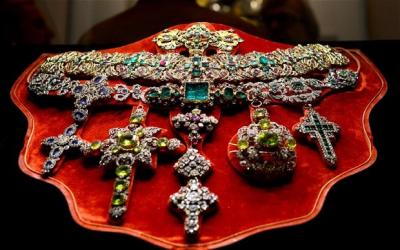Books: How the Vatican saved San Gennaro's treasure

ROME--The Treasure of San Gennaro is probably the most valuable on earth. Some experts claim that it is worth more than the Queen of England’s crown jewels. Seventy years ago, its famous masterpieces (the marvellous necklace, the precious Mitre, covered with 3,000 diamonds, rubies and emeralds, and many golden chalices), returned to Naples.
These precious objects had been accumulated as gifts to San Gennaro for many years, dating back to the 14th Century. However, on March 5, 1947, after a four-year odyssey during the Second World War and the “Battle of Monte Cassino”, the masterpieces returned to their home.
During the conflict, an agreement was made with the Montecassino abbot, Don Gregorio Diamare, that the Treasure be moved there in order to escape the constant bomb attacks on Naples. Consequently, on May 26, 1943, the precious objects, contained in three wooden boxes, were hidden at the ancient abbey by Prince Stefano Colonna di Paliano, the vice-president of the Deputation of the San Gennaro Chapel.
In the autumn of 1943, Hitler decided to use the monastery hill as the strategic stronghold of the Gustav Line. However, on Oct. 19, monk Tommaso Leccisotti, vice-archivist and historian, managed to smuggle these three boxes to Rome in a German lorry, in secret from the German troops. On the arrival of the objects in Rome, Pope Pius XII accepted to hold them in the Vatican Library.
An Allied bombing destroyed the Montecassino Abbey on February 15, 1944, due to the military use of its immediate surroundings by German troops. The Treasure of San Gennaro, however, was safely stored in the Vatican. On March 5, 1947, nearly three years later, the Treasure finally returned to Naples.
Prince Stefano Colonna was driven in a car, not by the police, but by the so-called “King of Poggioreale”, Giuseppe Navarra, to collect the Treasure in Rome. Navarra was considered a true “guappo” and was rumoured to have some connections to the criminal organization, Camorra. The pair successfully picked up the boxes and despite an adventurous return-trip, which included overflowing rivers, dangerous bandits, and blocked roads, brought the Treasure back to Napoli.
The salient question is, of course, why did it return so late? Why did it take almost three years after the Liberation of Rome (June 4, 1944) to return to its home?
“Because the Vatican was reluctant to give it back to Naples” was the general answer given by some Neapolitan journalists and sources on the web. Until now.
New documents discovered by Nando Tasciotti, a former special correspondent for Il Messaggero, reveal that it was quite the opposite. Tasciotti has recently published a book on the Treasure’s odyssey during World War II and this exciting revelation changes what people thought they knew about the Treasure of San Gennaro.
The document reveals that on Aug. 17, 1944, don Mauro Inguanez, the Montecassino Abbey archivist, informed Prince Stefano that the Vatican Library were ready to return the Treasure back to the city of Naples. In fact, it was the Neapolitan Deputation who unanimously decided to “postpone” the return of these three precious boxes, as they claimed they were safer in the Vatican.
It is a tale full of coincidence and strangeness told with a journalist’s ability to communicate. Many anecdotes are to be found within this work and the combination of the spiritual and the historical leads to a “history is so much stranger than fiction” moment many times over.
Nando Tasciotti is a true scholar on the matter; in 2014 he published Montecassino 1944. His reliance on facts and clear passion for the project shines through in a beautifully produced book of 98 pages. The history is concise and his writing is lucid, making the backward and forwards movement of the treasure decipherable.
Nando Tasciotti, San Gennaro a Montecassino. Come fu salvato il Tesoro nella Seconda guerra mondiale, Youcanprint, 98 pages, 10 euros.


